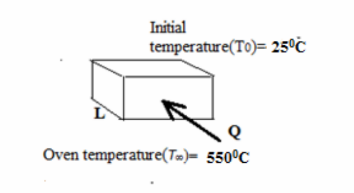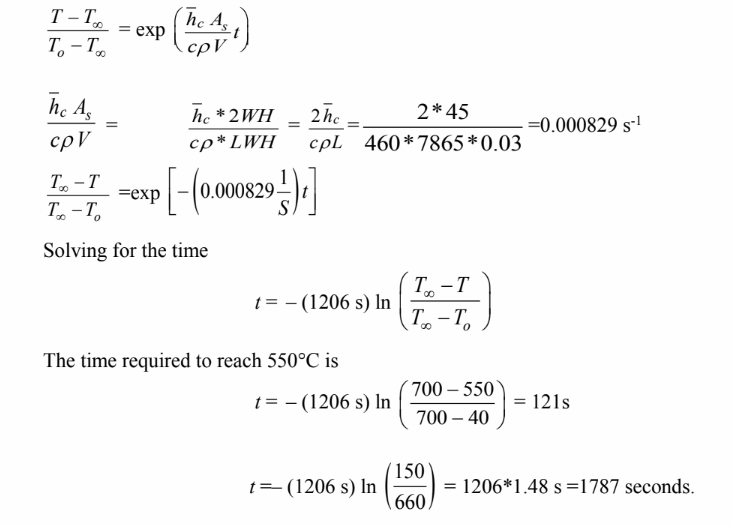In the heat treating process in a sheet-metal manufacturing plant, brass plates are annealed by first heating them in an industrial furnace oven the inside of which is maintained at a constant uniform temperature of 550°C. If the surface of the brass plate, which has a thickness of 2.5 cm, is initially at a uniform temperature of 25°C, determine the time required for heating the plate surface to 300°C after the plate has been placed inside the oven. Consider that heat transfer from the oven gases to the plate is by convection and that 135 ch = W/m2 K.
GIVEN
• Brass plate of thickness L=2.5 cm=0.025 m
• Initial temperature of the plate (To) = 25°C
• Heat treating oven temperature (T?) = 550°C
• Convective heat transfer coefficient ( ch ) = 135 W/(m2 K)
FIND
• The time required for the plate to reach temperature of 3000C.
ASSUMPTIONS
• Constant thermal conductivity
• End effects are negligible
SKETCH

PROPERTIES AND CONSTANTS
As per the information provided:
Thermal conductivity (k) = 50 W/(m K) Specific heat (c) = 460 J/(kg K) Density (?) = 7865 kg/m3
For a flat plate we have Lc=L/2= 0.0125 m
Biot number(Bi)= ch Lc/k=45*0.0125/50=0.0135 which is << 0.1
Thus the flat plate can be considered as lumped capacitance. Therefore, the internal resistance of the rod is negligible.
The temperature-time history of the rod,

You might also like to view...
According to the following figure, about how long ago did oxygen reach its current abundance in Earth's atmosphere?
a. 3 billion years ago b. 1 billion years ago c. 0.5 billion years ago d. 0.25 billion years ago e. 0.1 billion years ago
A current-carrying 2.0-cm long segment of wire is inside a long solenoid (radius = 4.0 cm, n = 800 turns/m, current = 50 mA). The wire segment is oriented perpendicularly to the axis of the solenoid. If the current in the wire segment is 12 A, what is the magnitude of the magnetic force on this segment?
a. 22 ?N b. 16 ?N c. 18 ?N d. 12 ?N e. 0 ?N
A solar mass star will evolve off the main sequence when:
A) it completely runs out of hydrogen. B) it expels a planetary nebula to cool off and release radiation. C) it explodes as a violent nova. D) it builds up a core of inert helium. E) it loses all its neutrinos, so fusion must cease.
A taxicab moves five blocks due north, five blocks due east, and another three blocks due north. Assume all blocks are of equal size. How far is the taxi from its starting point?
a. 13 blocks b. 9.4 blocks c. 9.2 blocks d. 8.6 blocks